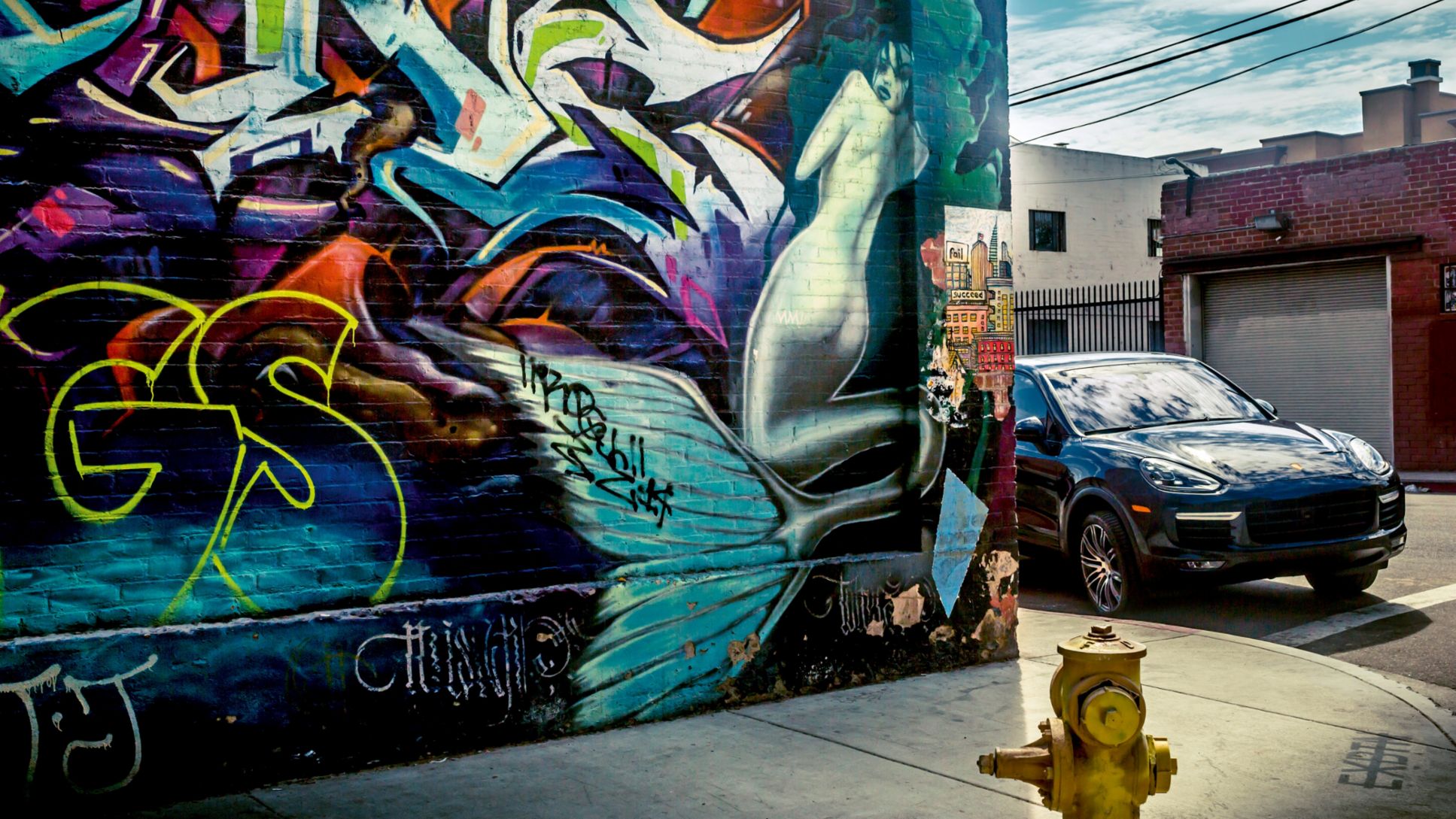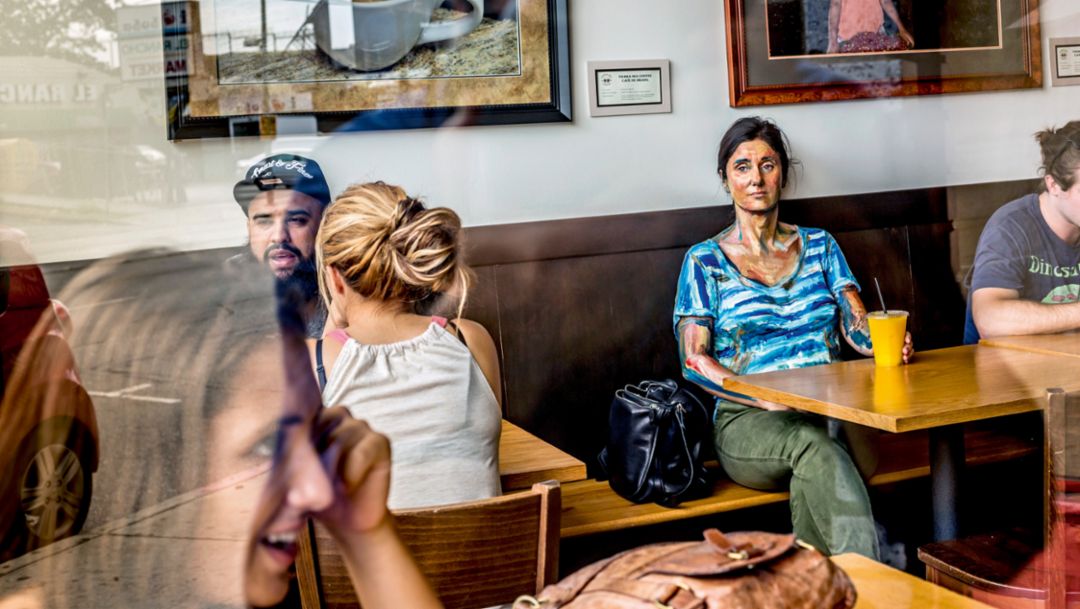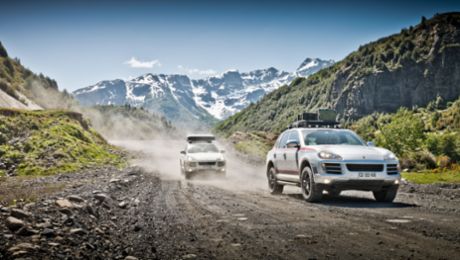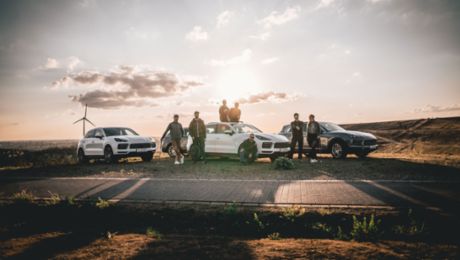The composition of person and background creates the portrait. In doing so, Alexa Meade challenges our customary modes of perception—not to mention the self-image of her models. The drive to the studio winds through the asphalt jungle of Los Angeles, past graffiti-covered walls (fascinating tableaux interspersed with meaningless tags), cafés, and all manner of everyday life.
Echo Park is a trendy neighborhood favored by artists, photographers, and musicians. It is an older district, slightly bohemian and still intact, not yet taken over by business interests. Right off Alvarado Street the vegetation becomes denser, with single-family houses perched along the steep roads. Every once in a while, a car simply cannot make it up the inclines. Alexa Meade—auburn-haired, freckled, and barefoot—leads us up a rainbow-painted flight of stairs to her home.
She paints skin on skin, lips on lips, eyelids on eyelids
In the living room, which also serves as Meade’s bedroom and studio, she creates exceptional works of art. You could call them portraits, but they are also performances. Meade covers people with acrylic paint until they themselves look like portraits. She paints skin on skin, lips on lips, eyelids on eyelids, until viewers no longer perceive the figures as three-dimensional entities but instead as two-dimensional surfaces. Over the course of about six hours, she reduces her subjects to planes. Two-dimensionality becomes an art form in an age of three-dimensional revolutions. Yet the subjects of her art become more vibrant, more radiant. She positions her models in front of pre-existing colorful backgrounds. She then takes her paint-smeared Canon or her surprisingly unmarked smartphone and proceeds to document these transient works of art in the form of photographs. Only the unpainted hair and eyes reveal the fact that the images are not traditional paintings.
Meade’s work questions what it is we are actually perceiving and shakes up our understanding of art, space, and reality. The effect is even more disconcerting when she incorporates one of her models into a three-dimensional space, or reality, instead of against a flat backdrop. It takes a while for viewers to actually comprehend what they see. “To me, the process of painting people on people is a new way of packaging the same basic information while creating the semblance of something completely new on the surface,” she says as she daubs paint on the insides of my ears with quick, precise strokes. “It’s the same person on the inside—my interpretation merely adds a thin veneer to the outside.”
A change in direction
Alexa Meade was born in Washington, D.C., in 1986. Like many young people growing up in the nation’s capital, she dreamed of going into politics. “I was planning to run for a seat in the House of Representatives when I turned 25,” she says. She studied political science at the elite Vassar College and worked in the press corps for the Obama campaign in Colorado, but then decided to pursue art.
Meade taught herself to paint. Her studio was her parents’ basement. She started by practicing with nature, painting trees and grass to capture their shadows. Then she began to experiment with the human form. She wanted to see what would happen if she painted shadows on people’s shadows. In the process, she discovered that she could turn people into two-dimensional images. “I was always fascinated by space, light, and shadow,” she remarks. “Canvas doesn’t interest me.”
Alexa’s breakthrough
Although her parents were initially less than optimistic about the prospect of their daughter earning a livable income in this field, Meade wanted to know what it would be like to devote herself to art full time. True to her enterprising spirit, she visited numerous art events and galleries and wrote down the names of artists whose work she admired. She then contacted those individuals and peppered them with questions over a cup of coffee.
And then her day arrived. In October of 2009, she painted her younger sister, Julie, as a still life in earth tones at the Positron Gallery in Baltimore. What followed was an entirely unexpected breakthrough. Jason Kottke, an influential blogger, had published a short piece on body painting, and an acquaintance of Meade’s commented on the piece with the suggestion that he take a look at her work. Kottke then posted a photo of the painted Julie, entirely unbeknownst to Meade. “A few hours later my inbox was overflowing, and people were calling me from around the world—including Playboy in Russia, which wanted me to paint naked women.”
Meade is not the first artist to use the human body as a canvas. But something about her technique is different, and it draws people in. “A lot of art goes through the intellect, which means people really have to think about it,” says Ingo Seufert, who owns the gallery that displays her work in Munich. “But the only art that has truly spoken to me viscerally over the past few years has been that of Alexa Meade.”
Astonished faces
Meade has shown her work in leading museums and galleries throughout the world, including the National Portrait Gallery in Washington, D.C., the Saatchi Gallery in London, and the Pinacothèque and the Musée Maillol in Paris. Her photographs often command prices in the four-figure range, and sometimes even higher.
Meade moved to Los Angeles three years ago to work with performance artist and actress Sheila Vand. Their collaboration ended when Vand’s acting career took off, but Meade stayed. “The incredible light and sunshine here in Southern California inspire me. And I’ve also found a community—everyone who comes to L.A. has a dream.” These dreams, she adds, have nothing to do with business suits, offices, or politics.
You forget that you are an object
On the way back from hilly Echo Park to the flats of Central Los Angeles, I realize that the dried layer of paint completely vanishes from the consciousness of the model. You forget that you are an object. Only when the car stops at an intersection do I see my two-dimensionality reflected in the astonished faces of drivers and pedestrians who are confounded by Meade’s artistic rendering of me. This is what art should do: it should confound us, galvanize us, and make us aware of what we are really seeing. Art in the blink of an eye.
Info
Text first published in the Porsche customer magazine Christophorus, No. 377
Text by Helene Laube // Photos: Theodor Barth
Consumption data
Cayenne: Combined fuel consumption: 9,2 l/100 km; CO2 emissions: 215 g/km





